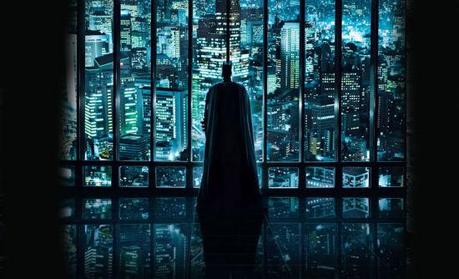
By Jonathan Morris, Antiscribe.com
(Note: I had planned to have this up last week, but after learning about the terrible events in Colorado, I though it best to wait a few days. Though it should go without saying, my thoughts and prayers are with the victims and their families, who were not only members of our greater American community, but fellow moviegoers and Batman fans. Though far, far, far from the most tragic aspect of this horror, it’s still somewhat unfortunate that it will forever be associated with Batman; as a figure in popular culture, the Dark Knight has always stood as a symbol against guns and gun violence, as well as an idealization that hope and light can someday arise from great tragedy and darkness. Hopefully, as a nation and a society, once we’ve mourned and grieved these events – and learned from them – we will find our own way onward, toward hope and light.)
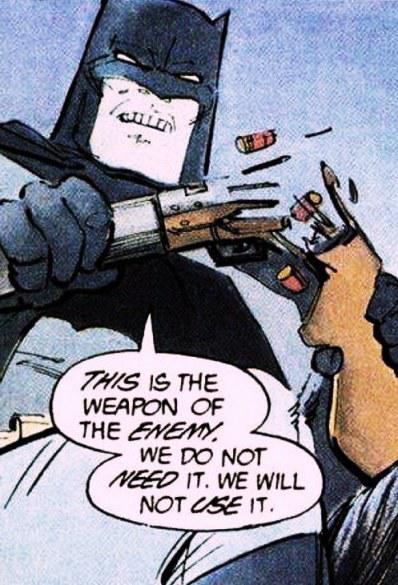
Though Batman used firearms in his first year of existence, he has since stood as a symbol against guns and gun violence.
Introduction
Welcome back to the second part of this epic overview of Batman through the years. Last time, of course, I looked at the character’s long history in animation, and this time I will be revisiting his even more notable history in live action film and television. In the previous edition, I also spoke a great deal about how Batman is such an extraordinary character in popular culture due to his incredible adaptability to the tastes and tones of any given era. Now I’d like to speak to why I think he holds so much appeal.
Needless to say, Batman has been increasingly seen, and especially more so since the 1970s and 80s, as a very dark character: the Dark Knight – a tragic, moody, often taciturn avenger that commonly plays straight man to typically far more ostentatious adversaries. As I discussed in my piece on Batman: Year One, the broad strokes of Batman’s origin are exceedingly well known, and for both his long-time and fair-weather fans, that origin is a big reason as to why his appeal is so universal. Everyone, somehow, somewhere, will be touched by terrible tragedy at some point in their lives, and will inevitably come face to face with the deep mourning and torrent of emotions that comes from the fact that what they’ve lost – no matter what, when, where, and how – can never ultimately be retrieved or restored.
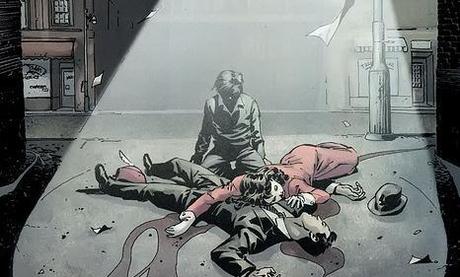
A large part of the Batman’s universal appeal is that he was born in tragedy, and tragedy is something that no one in this world, sadly, is exempt from.
Many heroes of history have been the victims of loss, from Gilgamesh to Hercules to the Lone Ranger to Spider-man, and that loss propels them, like the Batman, to make the world a better place (relatively speaking). What makes Batman different and special is that he is the hero who embraces his pain, externalizes it, and uses it as his greatest weapon. Batman, by all rights, should be a symbol of evil. He dresses like a nightmarish gargoyle and uses unsparing tactics, the greatest of which is his ability to strike boundless terror into the hearts of his enemies. Pulling on some of the most terrifying images of our collective unconscious, Batman doesn’t stand in the blinding light of justice and transparency, but cloaks himself in night and shadow. He protects the laws though he does not obey them, and he’s an engine of chaos that will stop at nothing to maintain order. Batman is a bringer of light, albeit one forever couched in darkness. In the end, he’s a mess of contradictions, but in a way that makes sense to all of us. For anyone who has known loss or tragedy knows pain, and Batman is a hero who feels our pain and embodies our primal desire to return pain to those who cause it. As terrifying as Batman is, he’s on our side, and no matter how times may change, we have the feeling that he always will be.
I first discovered Batman through cartoons, in both Adam West’s live action variety and the animated Super Friends. But very shortly after I was first introduced to Batman’s origin in the Super Powers episode “The Fear,” my dad bought me my first Batman comic. I don’t even remember the story, the villain, or whether even Robin was in it or not. What I remembered was HIM. This was not the cartoon character I watched playing second fiddle to Superman and Wonder Woman, the big brother to a garishly adorned teenage sidekick. This was something else entirely. To an eight year old, this was an icon of cool violence. He wasn’t just ears, a cape, and a mask, but long, terrifying ears on a stern mask with a billowing cape that seemed to encompass the darkened sky. When he struck someone it wasn’t just a cartoonish “POW,” but an explosion and release of righteous anger. To my young mind, the character he most reminded me of was Darth Vader, except in this case I had the tacit permission to cheer on this paragon of night. The Dark Knight has been a major part of my life ever since, and though I would grow out of comic books and superheroes for the most part, Batman proved to be a gateway to other things: to the world of film noir, to hardboiled literature, to Shakespeare, to mystery stories, and to the basic archetypes that have informed out storytelling for thousands of years.

Artist Neal Adams’ famous interpretation of Batman, which would have been similar to the first image of the Dark Knight I ever saw in comics.
Yet unlike many of the trappings of my childhood and other characters of comic books, Batman has seemed to become only more relevant for me with time. It’s of no great surprise that he became our most indicative post-September 11 superhero; the traumatized but proactive Batman was very much emblematic of our even more traumatized nation, as we, too, cloaked ourselves in the trappings of anger and pain, and lashed out our enemies (perceived and otherwise) using the tropes of fear and terror with a fervor that was, for a time, uncompromising. Of course, in the process it only demonstrated why Batman is and should remain a fantasy, as pain and trauma only begets itself, with no end in sight.
So while I still enjoy and appreciate the myth of the Batman and his Gotham City, which is simultaneously every city in the world and yet none of them, I do so nowadays with the sober eyes of a wizened, sophisticated adult. To me he no longer always represents childhood nostalgia or escapism (though he still does sometimes). More often than not, he feels more and more like the allegorical reflection of the society in which we live: of how close to the edge of its ethics it’s willing to go, and how it ultimately chooses to face its evils.
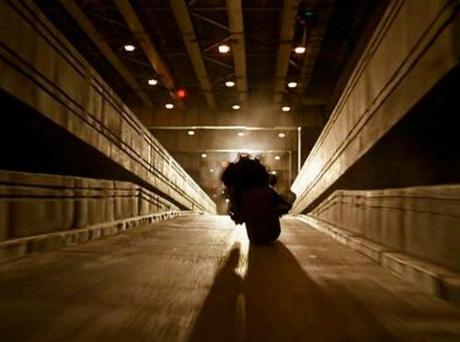
Though couched in the trappings of darkness and a symbol of fear, the Batman’s true legacy is as a bringer of light and hope.
Of course, given how much he has consistently reflected and been effected by an ever-changing society through the years it shouldn’t be surprising that Batman has been our most oft-filmed superhero (at least cinematically…Superman still has him outpaced in regards to television series). In fact, a large part of the story of superheroes in film is, in large part, the story of Batman in popular culture. And of course, as is always the case, some versions have been better, and some have been worse…
Batman (1943)/Batman and Robin (1949) – The Serials
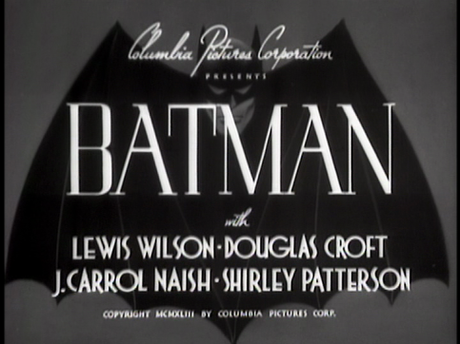
Pretty regularly overlooked these days (as are most film serials, really), these two twelve-part series made by Columbia Pictures marked the first depictions of Batman outside of the world of comics. Made somewhat inexpensively, they generally typified many issues common with old movie serials: poorly written, clumsily acted, extremely corny, and awash in continuity errors, narrative inconsistencies, and enough plot holes to drive a Mercury 8 through (which was actually used in one of the serials in lieu of a Batmobile). Though not without their interest or perverse charm, by today’s standards both of these series, despite their moments of unintended hilarity, are borderline unwatchable. In their time, though, they were very successful, and actually displayed far, far greater adherence to its source material than other serials typically did to other comic book characters; the Captain America serial, for instance, pretty much adapted the character’s costume and nothing else (not even his shield!).

Batman and Robin, as they appeared in the 1949 serial.
The first serial told of Batman (Lewis Wilson) and Robin (Douglas Craft) going into action to stop an evil Japanese agent named Dr. Daka (J. Carroll Naish) who had developed a mind-control device that turns people into mindless slaves. The second serial saw the Dynamic Duo (now Robert Lowery and Johnny Duncan) up against a mysterious master criminal named the Wizard, who devised an electronic device that can control automobiles and other vehicles. While the first of the two serials was the superior, technically speaking, being a product of the Second World War it was also appallingly racist. Not only was the villain Japanese, but his hideout was in an abandoned “Little Tokyo,” inside the “Japanese Cave of Horrors.” Little Tokyo was abandoned, by the way, because “a wise government (had) rounded up the shifty-eyed Japs;” which is, of course, a direct reference to and endorsement of this country’s forced internment of innocent Japanese-Americans. Sadly, even the Caped Crusader gets in on the slurs at a few points. Now, I know it was a different time, and while some may find the archaic racism funny in an absurd way, that doesn’t make it any more right or less shameful in retrospect. The second serial was appreciably worse, with an even lower budget, ill-fitting costumes, and huge gaps in logic; on the other hand, it didn’t racially stigmatize an entire ethnicity, so it’s got that going for it.

The villainous Japanese agent Dr. Daka (J. Carroll Naish). While dated in countless respects, the racism in the 1943 serial was by far its most archaic aspect.
Though seldom seen nowadays, the serials had a great influence on this history of the Caped Crusader. The idea of Batman having a subterranean hideout, initially called “the Bat’s Cave,” was actually first introduced in the 1943 serial. Also, Batman’s butler Alfred, presented initially in the comics as a portly, clean-shaven blowhard to be mined for comic relief, was portrayed in the serial as a thin, mustached, brave, and loyal ally; the comics soon adapted these traits to their version of Alfred and it has remained consistent with his presentation to this day.

The 1943 serial introduced the world to the Bat’s Cave, which of course became better known as the Batcave.
Probably their most pronounced area of influence, however, was that they directly inspired the later Adam West series. Though its somewhat apocryphal where the tradition actually began, by the 1960s it had became very common at many trendy parties to screen the films and mock them for their corniness; within a year or two, these screenings became a Saturday night fixture at the Playboy Club in Chicago, and an edited version of the 1943 serial made the rounds of college towns as An Evening with Batman and Robin. After a producer for ABC attended some of the Playboy Club screenings and saw the reaction they received from the audience, the idea for a Batman television series was born…
Batfact: The first of the Batman serials ran into some interesting censorship, though not sadly for their racial content. Since the production code restricted positive depictions of vigilantism, Batman had to be specifically classified in the film as a lawful, deputized government agent.
Batman (1966-1968)
“Quick Robin…to the Batmobile!” If there was ever something that emphasized how adaptable Batman is to different times and different eras, it was this iconic 1960s show. Though it seems to be less remembered with each passing year, this series was integral to the history of the Caped Crusader, making him, his mythology, and his iconography an ingrained part of the cultural consciousness and lexicon. Also, Batman marked the first time camp humor had been (intentionally) employed in a mainstream television show. Needless to say, though, this was anything but The Dark Knight…
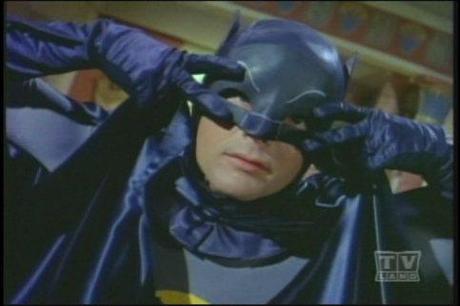
Batman (Adam West) doing the “Batusi.” Nope, no Dark Knight here. No sir.
If you are somehow one of those people who has never been exposed to the Batman TV show, the series was essentially a campy, light-hearted, hackneyed-as-all-hell presentation of the Batman that was far more interested in spoofing the iconic character than giving him his legitimate due. Produced by William Dozier, who was also the show’s famous omniscient narrator, the show had a keen disdain for its source material and was chiefly designed as a straight comedy that eviscerated comic books and other “juvenile entertainment” while drawing on the pop art/mod aesthetics that were all the rage at the time. Played to the hilt by Adam West and Burt Ward, Batman and Robin were shown as ridiculously noble heroes who, despite their considerable intelligence, gadgetry, and toughness, could always be counted on to be colossal idiots whenever the plot required them to be. The physically unimpressive West especially, so overdid his line readings that almost every performance he gave was like a pompous slap in the face of the know-it-all, unblemished heroes of the earlier generation’s Saturday morning serials (such as the one covered above). In fact, the show’s formula was drawn directly from the serials: aired twice a week for the majority of its run, the first episode of the pair would see Batman and Robin called in by the inept Commissioner Gordon and Irish Stereotype Police Chief O’Hara to investigate the “villain of the week.” After about twenty minutes of trying to figure out the villain’s scheme, the Dynamic Duo would inevitably get captured and subjected to some inordinately complicated death trap; this would serve as the episode’s cliff-hanger, after which Dozier would exclaim: “Tune in tomorrow! Same Bat-Time, same Bat-Channel!” The next episode would begin with Batman and Robin breaking out of the death trap, stopping the villain’s evil scheme, brawling with his/her henchmen (complete with the show’s trademark graphic exclaiming “Bam,” “Pow,” etc.), saving the day, and exiting the scene with Batman dropping a usually pithy remark. Rinse, repeat, see you next week…
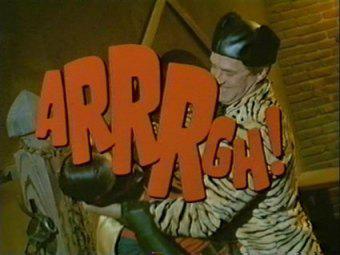
One of the campiest aspects of the “Batman” TV series was to use titles to emphasize violent sound effects, just like in a comic book.
Impressively, the show clicked because it managed to be two separate shows for two separate audiences. While adults saw it for what it was chiefly intended to be – high comedy – kids loved it as what it was actually sending up – comic book-style adventures. And though formulaic, the show was carried, as many versions of Batman often are, by the villains, played by a deluge of guest stars, including Victor Buono, Vincent Price, Liberace, Van Johnson, Art Carney, Maurice Evans, Joan Collins, Cliff Robertson, David Wayne, Milton Berle, Ann Baxter, and Zsa Zsa Gabor, among many others. The “Big Four” of the show’s villains, though, were the Joker, the Penguin, the Riddler, and Catwoman, played by Cesar Romero, Burgess Meredith, Frank Gorshin, and Julie Newmar, respectively (though Gorshin and Newmar were replaced by John Astin and Eartha Kitt at points in the series’ run). All four were fantastically campy in their roles, and Meredith and Newmar especially defined how their villains would forever be seen in the popular imagination.
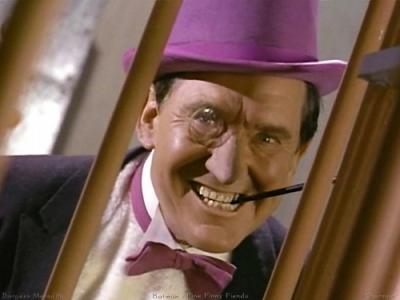
Burgess Meredith’s portrayal of the Penguin was one of the show’s most remembered villainous performances, and is still references every time Jon Stewart impersonates former Vice President Dick Cheney.
Meredith gave the Penguin an instantly recognizable cackle that was meant to imitate the squawking of his namesake, and is still to this day referenced on shows like The Daily Show with Jon Stewart (who invokes Meredith notably when impersonating Dick Cheney). Newmar’s Catwoman became something of a sex symbol, known for often “purring” her lines like a cat, something that would forever be associated with the character (though downplayed by most recent versions). Of them all, though, Gorshin’s Riddler probably stood out the most; playing the part with a kind of irrepressible, manic glee, Gorshin took what had previously been one of the comic book Batman’s more obscure foes and forever elevated him to the highest pantheon of the Dark Knight’s rogues’ gallery.

Just a sampling of Batman’s television rogues gallery, all of who were played by high profile guest stars camping it up like crazy.
An immediate hit when it debuted in early 1966, Batman spawned the first incarnation of what we now know as Batmania, and that year it was supposedly impossible to not go anywhere without seeing the Dynamic Duo’s likeness stamped on some piece of merchandise, or hearing some version of or variation on the famous title theme (including by The Who of all people):
As usually happens with fads, it didn’t last, and the show’s ratings had declined so greatly by only its third season that its budget was slashed and the show was cut to only half an hour weekly. To draw in more female viewers and to give Batman a dash of sex appeal, Yvonne de Carlo was added to the show as Batgirl/Barbara Gordon, but it wasn’t enough to curb the downward spiral and by early 1968 Batman was cancelled. Despite having only an initial run of a little over two years, the series became a fixture in syndication for most of the next twenty, and in the process became an ingrained rite of passage for kids growing up in the 70s and well into the 80s.
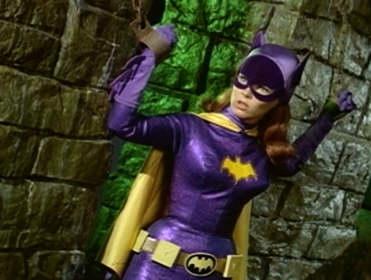
Batgirl (Yvonne Craig) was added to the show in its final season to try to renew interest. Here she is, in chains; somewhere, Wonder Woman is smiling.
Of course, in the modern era, this show proves to be pretty much a “love it” or “hate it” affair. Those who love it do so because they look back on it either with pronounced nostalgia or with great appreciation for its camp sense of humor. For many fans of the modern Batman, however, it’s a ready target for scorn and derision, standing as the complete anathema to the stark, serious Batman of the modern age. Regardless of how one may feel about the show, the role it played in Batman’s history cannot be denied. This series, for better or worse, ingrained elements of the Batman universe into the public imagination, and made the character a household name that has never been forgotten. And though Batmania burned briefly, it burned bright enough to increase sales of the comic (and actually all superhero comics) considerably and established the Dark Knight as a consistent source of merchandising revenue for Time Warner, who purchased DC Comics in 1969.
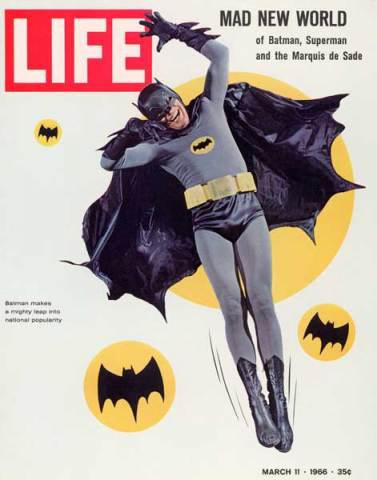
A few months into the show’s run, West’s Batman appeared on the cover of “Life” magazine, then one of the most popular and important periodicals in the country; in the eyes of many, this marked the beginning of “Batmania.”
My personal opinion of the show? I watched it fervently when I was in Kindergarten and as I said, this and Super Friends were my first exposures to Batman, so I do see the nostalgia that many hold for it. And for the first little while, there can be no denying that this show did a very good job at being a dead-on spoof and satire of hackneyed comic book stories; in the long run, though, its formula really didn’t have any legs, and it shouldn’t be at all surprising that the show was canceled so quickly. For me, though, at the end of the day, this just isn’t the Batman I enjoy anymore; I much prefer the Dark Knight to the Caped Crusader, and though I somewhat resent that the show treated a beloved character as a joke, I take comfort in the fact that its biggest audience historically – kids – enjoyed the show without really getting that joke.
Ironically, due to the fact the show was such a short-lived fad, those who crafted Batman comics found themselves forced to change the direction of their prominent character away from the campy tone of the series in order for it to survive. Under the custodianship of Dennis O’Neill, beginning in 1970 Batman was rather quickly transformed into a more somber, more serious avenger and detective, one that would evolve into the Dark Knight that we all know today. Robin/Dick Grayson was also shipped off to college, breaking up the Dynamic Duo after a thirty-year run and returning Batman to being, more often than not, a solo hero.
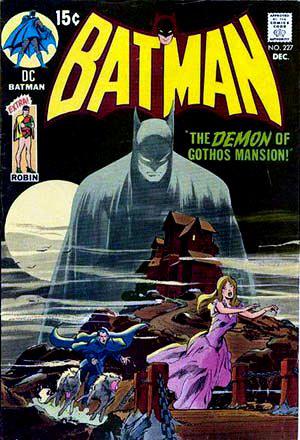
Batman Issue 227, December 1969, drawn by Neal Adams and written by Dennis O’Neill, marked the new beginning of the Batman, and his transformation into a true Dark Knight. The cover was intentionally similar to Detective Comics #31, printed thirty years earlier; in O’Neill’s eyes it symbolized taking Batman back to his darker roots as a lone, nocturnal avenger.
Batfact #1: Though demand for it has always been high, and it still shows up on cable syndication to this day (presently in the United States on The Hub), this series has never been officially made available on DVD or any other home media. There are manifold reasons out there as to why, but what it almost certainly boils down to is ownership rights. While DC Comics (now owned by Time Warner) owns the characters and trademark, they licensed them to ABC (now owned by Disney), who then licensed production of the show to 20th Century Fox (now owned by Newscorp…at least for the moment), who then co-produced it with Dozier’s Greenway Productions (owned by Dozier’s heirs). With the rights divided across so many parties (and major corporations), it has made securing a home video release close to impossible (though bootlegs are, naturally, plentiful).
Batfact #2: Riddle me this – who is the only actor to have played a villain on both the live-action Batman as well as Batman: The Animated Series? The answer: Roddy McDowall, who played the original series creation Bookworm on the Adam West show, and then delivered a very empathetic turn as the Mad Hatter on TAS.
Batman: The Movie (1966)
Originally conceived as being something of a grand scale pilot to the Batman series prior to it making the air, production scheduling forced this movie version of the then-popular show to be filmed instead after the completion of the first season. Shot in a little over a month, and then rushed into theaters by year’s end, Batman: The Movie, depending on whose perspective you believe, either marked the height of Batmania or the downfall of it. More than likely, it represented a little bit of both.
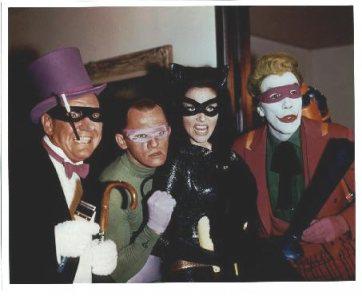
“Batman: The Movie” saw the Dynamic Duo outnumbered when their four biggest villains teamed up to take over the world.
The movie, which of course draws heavily on the cheeky, camp style of the series, tells of Batman and Robin facing their greatest challenge when their Big Four villains, the Penguin (Meredith), the Joker (Romero), the Riddler (Gorshin), and Catwoman (Lee Meriwhether, stepping in for the unavailable Julie Newmar) team-up to take the U.N. general assembly hostage and try to take over the world! While some like this in that “it is what it is” kind of way, this movie was silly even by the standards of the show; though it featured the first prominent appearance of the Batcopter and Batboat in pop culture, it also boasted the infamous use of “Bat-Shark-Repellent;” which of course begs the question: what is a Bat-Shark? That fact it was a feature film made its sense of humor somehow all the more trite, and by the time it starts satirizing international political relations, it had pretty much stretched its conceits far too thin.
Ultimately, the movie was not a box office success and indicated an overexposure of the character; for this reason, Batman: The Movie is pretty well regarded, one way or another, as the tipping point for Batmania.
Batfact: Interestingly, unlike the actual TV series, this has consistently been available on home video for most of the last 25 years, so for many fans of the Batman show, this represents their best and quickest available “Batfix” on the open market.
The Legends of the Superheroes (1978)
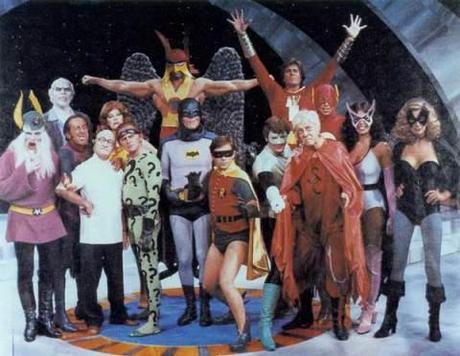
NO! NO! I…won’t. I can’t. Don’t make me! Aaagh!
Sigh, all right…all right…let’s just get this over with. This incredibly obscure series consisted of two specials produced by Hanna Barbera productions, intended as something of a live-action, though heavily satirical, version of their popular Challenge of the Super Friends cartoon. Featuring Adam West and Burt Ward returning to their roles as Batman and Robin, it also featured a number of other superheroes and villains, including Captain Marvel, the Green Lantern, the Atom, Giganta, and Solomon Grundy (Superman and Wonder Woman were spared the indignity because they were otherwise appearing on film and television, respectively). The first show was, generally speaking, intended as kind of live-action version of a typical, hackneyed, ludicrous Super Friends episode. While that was bad enough, the second episode was instead a take-off of a Friar’s roast, and generally brought out all the worst elements of variety television of the time. Collectively, these two shows were pretty much Batman’s equivalent of The Star Wars Holiday Special, and even people who liked the original 60s television show despised this.
Batfact: Following the original Batman series, Adam West (as well as both Burt Ward and Yvonne Craig) suffered severe typecasting. While West would work sporadically over the next twenty years, including voicing Batman in some of the animated series, he made part of his living appearing at conventions in costume as Batman. Fortunately, after Tim Burton’s Batman was released in 1989, West returned to the public eye and has repeatedly found consistent work as a voice actor, including on some of the various Batman television series. The most poignant of these was probably the Batman: The Animated Series episode “Beware the Gray Ghost,” which saw art imitate life as West portrayed an actor typecast from a superhero role he played decades earlier.
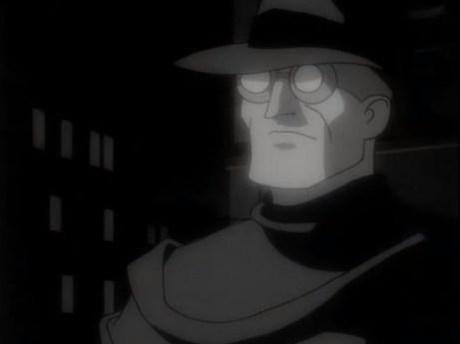
In one of his most poignant voice roles, on “Batman: The Animated Series,” West played Simon Trent, an actor, like West, who was typecast for playing a superhero – the Gray Ghost – on television years earlier.
Batman (1989)

For someone who lived through the phenomenon that was Tim Burton’s Batman, it’s sometimes kind of amazing to me how it’s gotten more and more overshadowed by the newer, and admittedly better, Christopher Nolan films. Make no mistake, though, this was the most anticipated film of its day, and one of the most brilliantly marketed films of its generation. Playing off the character’s prominence in popular culture, the film’s advertising pretty much evinced the character’s name in favor of his trademarked logo, and its rather minimalist trailer became a collector’s item in the days before DVD extras. Though its blockbuster status was essentially guaranteed before it was even released, when it arrived in theaters, it was nonetheless a revelation. This was a film far darker than any other mainstream blockbuster had ever been; and it was essentially the first time American popular culture had seen a long-established character not only modernized for a new generation, but completely recreated and reinterpreted as the antithesis of what they had previously known. In Burton’s Batman, gone were the blue cape and cowl and gray bodysuit that made Adam West look borderline ridiculous (before West pushed himself across that border); this was a true Dark Knight, swathed in black body armor, with an ominous mask and voice that was often little more than a taciturn whisper. This Batman, unlike his predecessors, wasn’t a children’s superhero, but something that seemed designed to strike fear in the hearts of criminals, and the world he lived in wasn’t a cartoon, but something out of an urban nightmare…
The film essentially tells a condensed version of the long saga of Batman and the Joker instead of a true origin story. In it, Batman (Michael Keaton) is still something of a new quantity in Gotham City and regarded as an urban myth; in his first major “coming out,” however, he finds himself in a confrontation with crime boss Jack Napier (Jack Nicholson). During their struggle, Napier is accidentally knocked into a vat of chemicals, bleaching his skin white and driving him entirely insane. Now transformed into the homicidal Joker, he begins a high-profile reign of terror, taking control of the criminal underworld with an eye more toward mass-murder than profit. And, of course, only Batman can stop him.
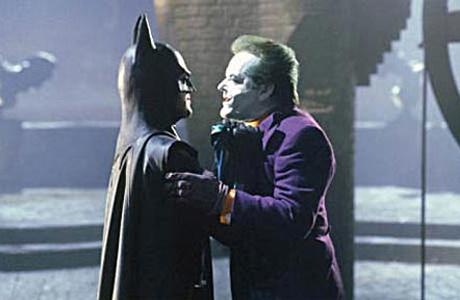
Rather than a straight origin, the film basically told a condensed version of the war between Batman (Michael Keaton) and the Joker (Jack Nicholson).
Though it proved critic-proof anyway, the film at the time received very mixed reviews, and in retrospect I think that speaks to just how strange and different Burton’s film was when compared to what was then the norm. Granted, I don’t find it to be an especially classic work of cinema or anything, and as Burton himself once said, “it was more a cultural phenomenon than a great movie;” nonetheless, Batman holds up as an entertaining and periodically compelling version of the character which, though dark in countenance, still finds a way to be remarkably fun. And while not possessing anywhere near the narrative depth and psychological complexity of Nolan’s later Dark Knight trilogy, Batman still may match those films in quality of craftsmanship.
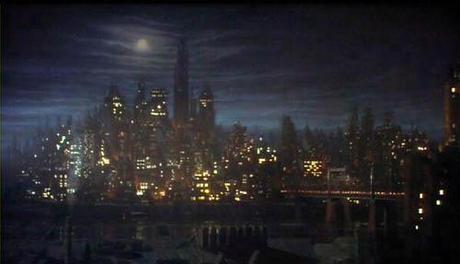
Batman’s Gotham City was both a nod to the gothic tradition as well as emblematic of 1980s urban decay.
As is typical of Burton films, what his movies lacks in narrative cohesion they usually supplement in visual grandeur, and here that was really no different. The film’s sumptuous production design presented a Gotham City that seemed almost like a gothic hellscape of urban decay, with buildings that seemed crafted more out of shadows than stones. If there’s one area, though, in which this Batman stands head and shoulders above its later reboot, it’s in Danny Elfman’s rousing, sometimes operatic, and occasionally hypnotic musical score, which perfectly balanced the unsettling mysteriousness of its hero with the gleeful menace of the Joker, as well as the ominous dread that was ever-present in Burton’s gothic Gotham.
Though since surpassed and overshadowed by Heath Ledger’s galvanizing, award-winning turn as the Clown Prince of Crime in The Dark Knight, Jack Nicholson was still in his over-the-top glory as the Joker. And while Ledger’s version certainly remains the more realistic and disturbing, Nicholson’s actually does a much better job representing the character as he appeared in the comics: as a cheerful but menacing homicidal sociopath whose ornate, grandiose plans generally lacked the later Joker’s ideological agenda. In another huge departure from the norm for the time, and still influencing movies to this day, Nicholson’s Joker was as much as if not more of a focus than Keaton’s Batman; Nicholson, it must be understood, was a much bigger star than Keaton at the time, and even received top billing and what turned out to be a very sweetheart deal that included a cut of the film’s box office. Keaton, who at the time was a very controversial choice for the role, remains a surprisingly good Bruce Wayne/Batman, even if he’s never really quite an ideal one.
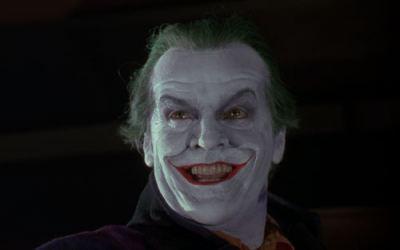
In one of the more trendsetting aspects of the film, the success of Jack Nicholson’s Joker made the casting of a film villains almost as important as the casting of their heroes; it also inspired numerous films to focus more on a scene-stealing villain rather than a hero.
As said, the film was a phenomenon, and proved to be such a media event in the summer of 1989 that it essentially launched the second coming of Batmania: T-shirts, baseball caps, shoes, sandals, and bathing suits featuring some variation of the Bat-symbol were everywhere (including on most everything I owned). Bat-merchandise of all varieties could essentially be found in virtually every store in the local mall, comic book sales skyrocketed, and, somewhat ironically, even renewed interest was taken in the Adam West series.
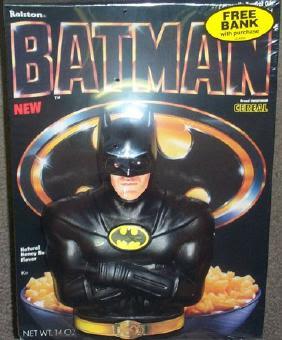
Batman was everywhere in 1989, even on breakfast cereal. It was delicious! And yes, I owned that bank.
Though, again, somewhat overshadowed by the Nolan films now, it needs to be noted that this was actually one of the more influential films in Hollywood history – and not really for the better. Though not as much of a game changer as Star Wars was a generation earlier, the impact of Batman on commercial moviemaking was profound. Scott Mendelson on Salon did an excellent job some years back of analyzing its influence here, but in short, Batman forever changed how films were marketed, produced, distributed, and merchandised, and it especially placed permanent emphasis in Hollywood on filming preexisting properties instead of creating new ones of its own. Batman was also the film that led to movies being “front-loaded,” placing greater emphasis on the opening weekend and starting the gradual contraction of the amount of time movies would typically spend in the theater. This led directly to the decline of second-run movie houses in favor of first run movie-megaplexes, as well a more rapid sell-through of home videos to the average consumer. Finally, I would add, that as an unfortunate byproduct of this success, it precipitated an even greater homogenization of Hollywood’s product and a decreased interest in deeper, more sophisticated fare. And make no mistake, for most of the next decade, films with even a modicum of similar subject matter tried to ape this movie’s success, commonly by coupling darker, antiheroic protagonists with over the top, scenery-chewing antagonists who typically outshone the hero. Indeed, the studios threw a lot of good money after bad trying to mimic the success of Batman, though none of them ever did (not even its sequels).
While Batman can, in many respects, be viewed as something of a culmination of 1980s postmodernism and commercialism, it also essentially marked the beginning of the 1990s. Released just after the end of the Reagan Presidency, and its emphasis on nostalgia for an earlier time, this black-clad Batman and his hyperrealized world of urban decay, corruption, and madness was a high profile symbol of the darkness and discomfort at the heart of the American psyche, and a testament that all that glittered, even in the bright day-glow neon of the 80s, was not gold. The runaway success of Batman marked a turn in popular culture toward darker popular entertainment, and in a lot of respects, we’ve never really turned back.
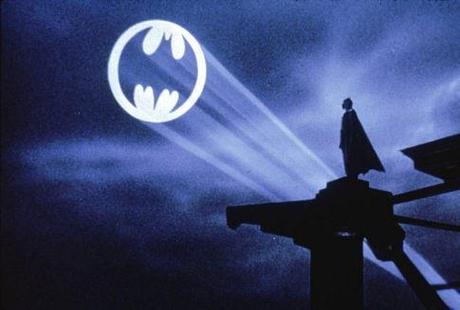
After “Batman,” for better or worse, nothing would ever be the same again.
Batfact: While a cultural phenomenon and a merchandising machine back in 1989, there was one area where it was felt Batman merchandising had fallen short: toys. Unlike Star Wars, Masters of the Universe, and other major properties of the time, Batman only featured three characters that really lent themselves to being made into action figures: Batman, the Joker, and, in a real stretch, Joker’s henchman Bob. As a result, the line was supplemented with other DC Comics characters like Wonder Woman, Lex Luthor, and the Penguin. Producer ToyBiz surprisingly lost money on the line, and after DC and ToyBiz went their separate ways, the license was picked up the next year by Kenner Toys. While it may seem insignificant, from Batman Returns onward, there came a greater focus on putting more and more merchandisable characters on screen in each film, which, by 1997’s Batman & Robin,had more than passed the point of overkill.
Batman Returns (1992)
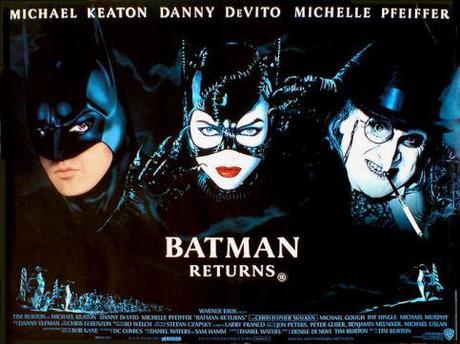
Burton’s much-anticipated follow-up to his original blockbuster, Batman Returns arrived amidst great hype in the summer of 1992 but was almost immediately the source of controversy. With Burton granted far greater creative control when compared to the first film, he ended up creating a sequel that managed to be even darker and gloomier than the original (though with a much lower body count, all things being equal). Instead of obviously fun and exciting, Batman Returns proved incredibly bleak and macabre, with a greater emphasis placed on sexuality and the grotesque that left audiences, and specifically family audiences, shell-shocked at the time. With that said, it has engendered a cultish appeal among many in the two decades since its release, and I know some people who find Returns to be their favorite of the original series.
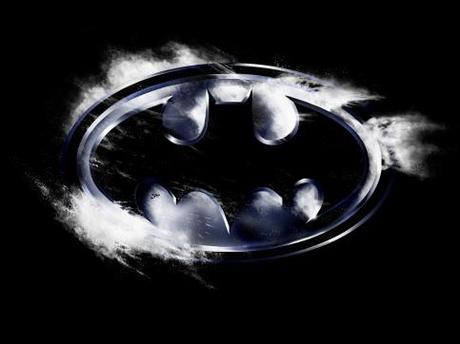
Personally, I just found it weird that “Batman Returns” was set during a snowy Christmas season but was released in June.
However, it absolutely cannot be denied that as a mainstream blockbuster, this film was a qualitative failure, and though Batman Returns remained profitable, it made significantly less than Batman did three years earlier. Arguably its biggest problem, creatively, was that it placed too much focus on the villains over Batman. While the first film was criticized in many quarters for this, here that focus was even more out of balance; with no less than THREE villains in this film (beginning an annoying tradition that would creatively compromise the rest of the series), our eponymous hero was sometimes left gasping for screen time. In fact, I would argue that he wasn’t even the film’s protagonist, with that role pretty much shared by “villains” the Penguin (Danny Devito) and Catwoman (Michelle Pfeiffer).
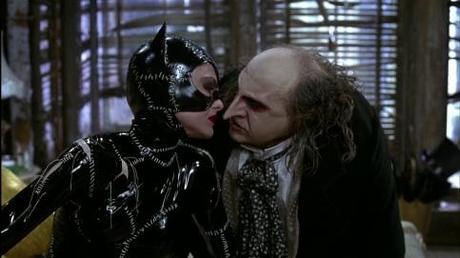
Exacerbating a trend from the original film, “Batman Returns” was much more focused on its villains, Catwoman and the Penguin, than it was on Batman.
Departing significantly from his comic counterpart, Burton and Devito’s Penguin wasn’t the dapper, goofy, and somewhat comical criminal mastermind Burgess Meredith made famous, but a deformed, monstrous, misanthropic maniac who basically looked like a full grown Thalidomide baby. Thrown into a river as an infant, Oswald Cobblepot is raised in the sewers to become Gotham’s fabled “penguin-man,” who blackmails Gotham’s evil business mogul, Max Schreck (Christopher Walken) into helping him “reclaim his birthright” as a member of the surface society so he can exact a horrible revenge on Gotham City. Selina Kyle, meanwhile, is Shreck’s put-upon, meek, and shy secretary; after being pushed out a high window for stumbling on one her boss’s evil plans, she has a psychotic break, assuming the role of the sexy, empowered, and vengeful Catwoman. Both, of course, before long run up against the Batman, with Catwoman especially proving to be a very tricky and personal foe, especially when their alter-egos meet and begin to fall in love…
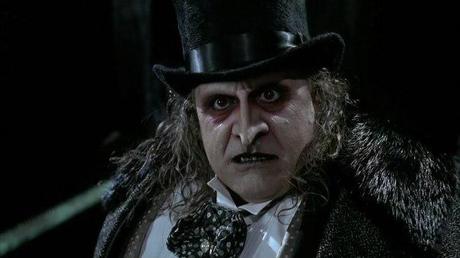
A far cry from his comic book namesake, Burton and Devito’s grotesque and unpleasant Penguin was often too much for audiences in 1992, though Devito did a fine job bringing him to life.
For a film that was marketed and merchandised as a kids movie, people had every right to be upset with what Burton actually gave them; when it was first released, I myself witnessed firsthand all the children under age eight being led crying from the theater as the movie went along; by the time the Penguin tried to bite someone’s nose off, a significant part of my theater had cleared out. Of course, those kids and parents, had they remained, would have seen Penguin attempting to mass murder all of Gotham’s first born children, so it was probably good that they left when they did. And perhaps more than any film he’s done, this stands as Burton’s most egregious example of sacrificing plot for style. While the film looks absolutely fantastic, its story sometimes makes little sense and is full of frustrating contrivances that stretch “suspension of disbelief” well past its breaking point. (I mean seriously…how does the Penguin get a bunch of rocket launchers on hundreds of penguins in like, five minutes?
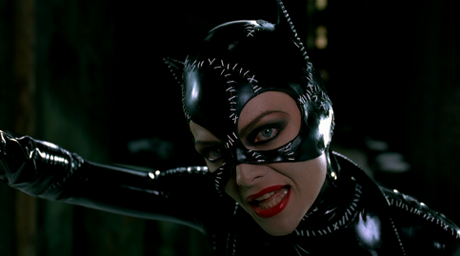
Though the storyline of Catwoman (Michelle Pfeiflfer) could be a little illogical and contrived, Pfeiffer was fantastically tragic in the role.
With all of that said, there’s a lot about this movie that I actually really, really enjoy. Danny Elfman arguably surpassed himself with his score here, which, for better or worse, often beautifully adds to the film’s melancholic aura; his pieces for Catwoman, especially, are amazingly evocative and raw.
The actors’ performances were also utterly fantastic; though Penguin was undeniably the film’s leading liability, Devito did a fine job playing him, and Michelle Pfeiffer was brilliant at playing a very troubled yet alluring Catwoman. Walken, though, sometimes threatened to steal the movie as Schreck, playing him as something of a cross between Donald Trump and Albert Einstein, and it stands as one of the definitive “Walken performances.” And though Daniel Waters’ script often leaves the plot dangling, some of his dialog is absolutely superb.
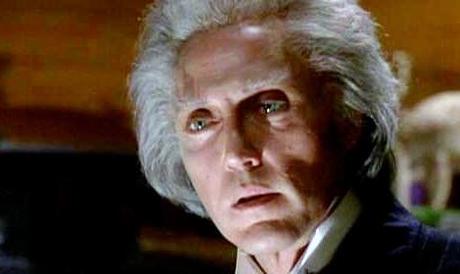
As he often does, Christopher Walken periodically came close to stealing the movie as the villainous mogul Max Schreck, a character created for the movie.
What I probably appreciate most about Batman Returns is that it represents the best presentation of the Batman/Catwoman relationship I’ve ever seen; whether they were fighting or flirting, Keaton and Pfeiffer had amazing chemistry, and the film does a beautiful job playing them off each other as badly broken people with a duality that splits them “right down the center.”
Watching it today, it helps to look at Batman Returns as a high budget black comedy in a blockbuster’s clothing, and it actually presaged the often grisly turn that Batman comics have taken in the last two decades. Naturally, given the backlash to the movie and its underwhelming box office, Tim Burton wasn’t asked to return for a third movie, and as a direct result, Keaton also departed the role. At the time, Burton’s exit was absolutely the right call; unfortunately, though, Warner Bros. decidedly overcompensated after Batman Returns, exerting even more corporate control over the series and taking the next film much, much too far in the opposite direction…
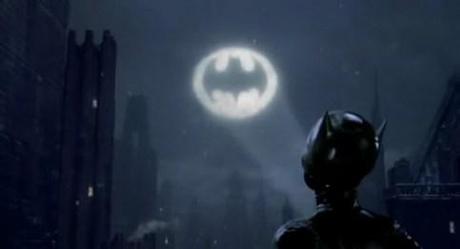
Though maligned and controversial in its time, “Batman Returns” has developed a strong cult following over the last two decades.
Batfact: While it most certainly would have been one character beyond “one character too many,” there were originally plans for Robin to be in the film; however, the character would have been a distinct departure from the Boy Wonder we all know, and instead of being an orphaned child of circus acrobats, he would have been a young auto mechanic and/or juvenile gang leader. He also apparently would have been African-American; Marlon Wayans, in fact, was hired and paid for the role and claims to have attended a wardrobe fitting for the character, but of course never actually performed in this or any of the subsequent films.
Batman Forever (1995)
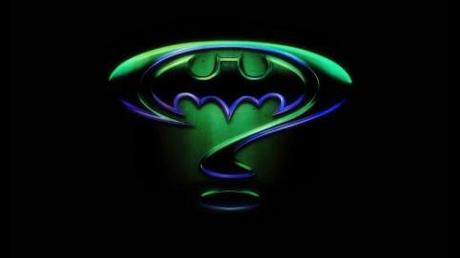
A much maligned movie, especially after the success of Nolan’s Dark Knight trilogy, Batman Forever was essentially an equal and opposite reaction to Burton’s nihilistic Batman Returns, taking Batman away from a dark Gotham City and placing him within an Las Vegas-like cartoon world. With director Joel Schumacher at the helm, Batman Forever, more than simply trying to be a more family-friendly version of Batman, went even further than that, becoming essentially a more modernized version of the Adam West show. Unfortunately, this wasn’t the 1960s, but the 1990s, and the return to a camp aesthetic was for many, thoroughly unwelcome.
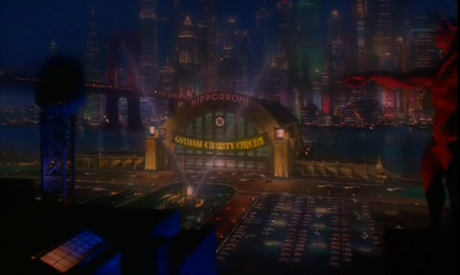
Presented as an often overlit, bright, neon-soaked, the Gotham City of “Batman Forever” often felt like Las Vegas without the gambling and legalized prostitution. In other words, mostly unbearable.
A camp cartoon is really what Batman Forever essentially proved to be (complete with lame-ass sound effects). Where Burton’s Batman had been dark, Batman Forever was colorful to the point of garish, and where it had been serious, Schumacher’s film aimed to be jokey. Like the Adam West series, the movie’s script was chock full of bad puns (really, really bad puns) and double entendres, and hewed much closer to the ludicrous and fantastical than Burton’s version ever dared (did I mention the sound effects?”. The resulting film is difficult, if not impossible, to take seriously, though if nothing else it was far more palatable for a family audience than Batman Returns had been.
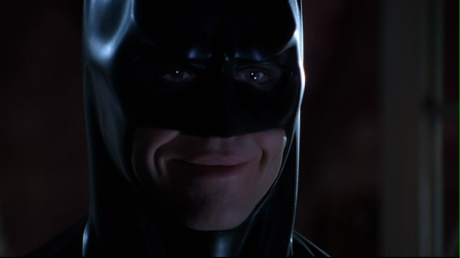
“Batman Forever” tried to recreate a more family-friendly Caped Crusader, and in the opinion of everyone went way too far in the wrong direction.
The film saw Batman again facing two villains, each of whom played on one of his dual personas. The first was Two-Face, played by Tommy Lee Jones as a one-dimensional (ironically) cackling psychopath who wants revenge on Batman, and the second was the Riddler, played by Jim Carrey, an evil genius with a mind reading device who’s pathologically obsessed with Bruce Wayne. While Carrey was in his element in this type of part, Jones was clearly doing it for the money; sadly, that didn’t stop either of them from trying to see which of the them could go more over-the-top or chew more of the overglossed scenery than the other. Overall, they emblematised the movie perfectly, as Batman Forever was just too broad, too loud, too obnoxious, and too excessive in just about every respect.

Beyond over-the-top and beyond obnoxious Jim Carrey’s Riddler and Tommy Lee Jones’ Two-Face were also at time a little too touchy-feely for some people’s comfort.
I can’t honestly say, though, that this movie is quite as awful as its reputation. What’s bad in it is plenty, plenty bad, and Schumacher’s entire creative direction was just completely wrong headed in every way, but writer Akiva Goldsman actually did try to return some of the focus to Bruce Wayne/Batman, giving him a romantic interest in the form of a sexy psychiatrist (Nicole Kidman), who helps the Dark Knight confront his internal conflict with duality. The film also does a decent job with developing the Dick Grayson/Robin narrative, and though somewhat too old for the role, O’Donnell worked as a moody and rebellious Boy Wonder. Not surprisingly, it was Batman who ultimately held the film together, and Kilmer’s decision to play him as earnest, serious, and straight, despite the ludicrous cartoon going on around him, kept Batman Forever from slipping completely into ludicrousness. (So, of course, they replaced him in the next movie.)
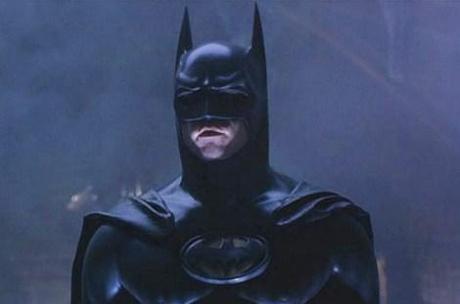
Though hardly the ideal Dark Knight, Kilmer wisely portrayed his Batman as mostly grounded despite the ridiculous cartoon going on around him.
Where Batman Forever still proves to be something of an interesting discussion starter is that Schumacher, who does happen to be gay, filled his already campy movie with homoerotic innuendo and queer aesthetic choices; perhaps most notable were Batman and Robin’s anatomically explicit costumes, which rather infamously featured nipples and rather pronounced codpieces (not to mention numerous close-ups of both). Even now, it remains a very debatable point as to whether it was appropriate for Schumacher to included such material in the film.
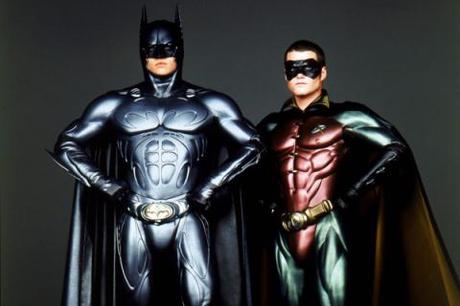
The anatomically explicit outfits in “Batman Forever” were the source of much discussion back in 1995, and led to subsequent debates over whether or not Joel Schumacher’s gay innuendo and aesthetic in the movie was either appropriate or effective.
Now there have certainly been a great many queer analyses of Batman through the ages, and not without good reason; but they have often reflected a niche perception that can be intriguing but ultimately teleological, meaning that its representations were commonly done without the artist/writer’s intention.
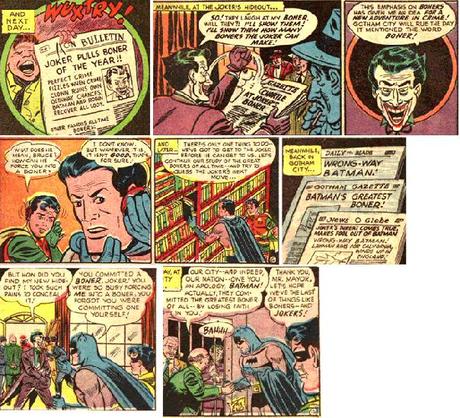
Case in point…
Here, it was intentional, and thus has to be judged on how effective it was. For me, it’s not that the material may or not be gay that was its problem; it’s that it subtracted from the film rather than added to it, and in the process were done in contexts that didn’t make the material anymore intriguing or insightful. For instance, why have your two villains essentially groping each other and prancing around your sets? How did implying a homoerotic bond between them benefit a gay perspective? It didn’t, and it felt more like the self-indulgence of its director more than anything that really had something to say or add to his film.
While Nolan and Burton tried to make Batman into a bad-ass, Schumacher was more about showing some Bat-Ass. (Drum roll…) Honestly, I’m someone who supports gay rights and appreciates queer-influenced art and writing, and I still find Schumacher’s innuendo and imagery to be just completely out of place here.
Unfortunately, Batman Forever proved to be a pretty major box office success despite some truly wretched word of mouth, and in a way that success proved to be the doom of the series; but we’ll get to that in a moment…
Batfact: The sexual orientation of Batman creator, Bob Kane, has actually been a source of some speculation over the years. Kane was known as a dapper dresser and for being fairly ostentatious; he also claimed to be an avid womanizer who even bragged in his later years about having an affair with Marilyn Monroe (a claim few actually believed and that doesn’t hold up to much scrutiny). Whether he was overcompensating or not for the life of a deeply closeted gay man, of course, remains speculation only. Kane was married only once, later in life, to a much younger woman, and had a daughter from a previous relationship; he passed away in 1998 at the age of 83.
Batman & Robin (1997)

In case you can’t tell, that’s supposed to be Batman’s logo mounted behind…um…never mind.
There’s a common recurrence in Hollywood that you’ll see well too often, where an unremarkable and/or mediocre film somehow manages to become successful, and as a result the people behind the film suddenly think that they’re infallible. Therefore, when it comes time for the filmmakers to create a sequel or follow-up, instead of learning from the successes and failures of the previous work, they treat all parts of it as if they were successes alone. The end result is often a new film that is worse, and sometimes significantly worse, than its predecessor. While I’m sure everyone has their own name for this phenomenon, I personally call it the Joel Schumacher Effect, and Batman & Robin is the reason why.
Rushed quickly into production on the heels of Batman Forever’s success (so quickly that Val Kilmer was fired for not being able to return to the part immediately), Batman & Robin stands not only as the worst Batman movie, but the worst superhero movie of all time and one of the worst films of the 90s. This is, at the end of the day, just a colossally unwatchable waste of time and especially of money, and it not only tanked the Batman franchise but pretty much killed the genre of the superhero film dead until X-Men in 2000 and more significantly Spider-Man in 2002 brought it back to prominence by reminding people that just because a movie had a superhero in it didn’t necessarily mean it sucked.
With George Clooney stepping into the role of Batman/Bruce Wayne (and in the process giving one of the worst performances of his otherwise superb career), Batman & Robin saw the Dynamic Duo again facing one villain too many as they did battle with the cold-hearted Mr. Freeze (an unbearable Arnold Schwarzenegger) and the seductive Poison Ivy (a sexy but clearly embarrassed Uma Thurman). They were also helped by a new ally, Batgirl, played by Alicia Silverstone, who through her performance pretty much squandered all the goodwill she received from her star-making turn from Clueless. Really, no matter how you may feel about individual members of the cast, none of them ever had a chance to get away unscathed. This took everything that was bad about Batman Forever and actually doubled- and even tripled-down on them: it was even campier, featured even more painfully awkward gay innuendo, included more terrible one-liners, and displayed sets and costumes that made Batman Forever’s seem like an exercise in understatement. Even worse, while the last film at least tried to have Batman retain some gravitas, here Schumacher and Clooney made the Dark Knight as much a joke as everything else in the movie, and equally unfunny to boot.
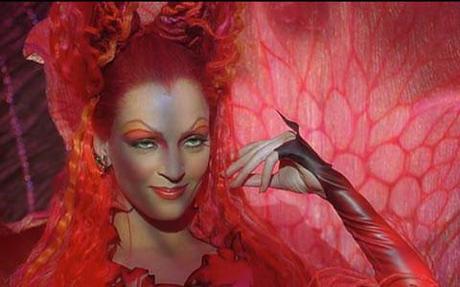
Of course, one of the film’s villains would be Poison Ivy, a femme fatale whose kiss could kill. Given Schumacher, I’m sure the symbolism should be obvious.
While Schumacher doesn’t deserve all the condemnation for this film, he certainly deserves most of it. The studio absolutely tried to turn this movie around too quickly, and their decision to bring in a toy company to design their costumes showed where their priorities lay. But Schumacher had no excuse not to learn from the previous film; while Batman Forever was successful, its word-of-mouth was positively noxious, and it was pretty clear from everyone who saw the movie that they wanted its campiness pulled back just as much as they wanted a dialing back on the grimness after Batman Returns. Instead, he pushed even harder towards making “his Batman,” and in the process made the absolute anathema of what anyone wanted to see. Case in point: I’m a pretty huge Batman fan, and I waited eight years before finally watching this movie, and even then, it was worse than anything I could have imagined. The film also had a very disappointing opening, and didn’t even make its production budget back in the North American box office. To his credit, or perhaps not, Schumacher has pretty much apologized for this movie repeatedly, and almost everyone involved in it has disavowed it at one time or another.
Batfact: John Glover, who portrayed Jason Woodrue, the mad scientist who helped create Poison Ivy, had previously voiced the Riddler on Batman: The Animated Series.
Birds of Prey (2002-2003)

This was kind of a blink-and-you’ll miss it series that aired on the WB for a few months beginning in the fall of 2002, and was produced by some of the same people who conceived the long-lived Smallville. It was based loosely – very loosely – on Gail Simone’s popular comic, which was about a superhero group of mostly female members led by the wheel-chair bound Barbara Gordon, the former Batgirl. The main concept of the show was that it was set years after Batman and the Joker had their final confrontation, which ended with Batgirl crippled and Catwoman murdered. Grief-stricken over the loss of the love of his life, Batman/Bruce Wayne abandoned Gotham City, leaving it essentially in the hands of Gordon, now known as Oracle, and his daughter with Catwoman, the Huntress (the Helena Wayne version from pre-Crisis on Infinite Earths, not the Helena Bertinelli one of the modern era, for those who care about that kind of thing). That right there was pretty much a major strike against the show from the beginning: the insinuation that Batman would actually completely give up and run away, let alone abandon his daughter, pretty much ruined whatever credibility this might have had with Batman fans.
I gave this show a shot, since I admired the original comic for presenting an all-female team from an actual female perspective (DC Comics, you have to understand, is notoriously backward on things like gender equality and multiculturalism), but this was just a very poorly done, overly hackneyed, ill-conceived series that absolutely deserved to be cancelled, which it fortunately was after only 13 episodes.
Batfact: Some years later, a young, pre-Batman Bruce Wayne was actually due to become a reoccurring character on Smallville, but Warner Bros., concerned about “brand confusion” with the Nolan film series (yeah, like that would have happened…) vetoed the idea. As a result, the producers instead tapped the character of Oliver Queen, AKA the Green Arrow, who like Batman was a billionaire moonlighting as a superhero.
Batman Begins (2005)
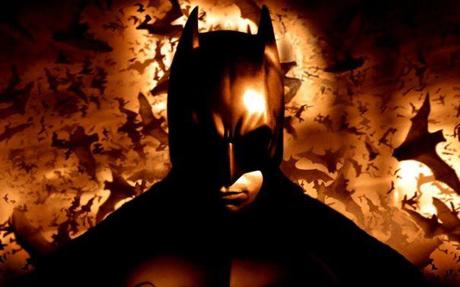
Believe or not, when this film came out in 2005, it was with very, very low expectations and not a great deal of hype. Though it was a full eight years after Batman & Robin, Batman, as a brand, was seen as damaged goods as movie properties went; therefore, when it was released, the film made less than $50 million its opening weekend – less than Batman Forever did a full decade earlier with lower ticket prices. However, between an often glowing critical reception and ebullient word-of-mouth, Batman Begins maintained and grew to be financially successful enough to launch a new franchise; some even asserting that it was, up until that point, the greatest superhero movie of all time, and undeniably the greatest Batman movie ever made.
Though it now sits somewhat in the shadow of its sequel, Batman Begins stands as a great film all its own, and in terms of depth, drama, and complexity absolutely dwarfed Burton’s original “cultural phenomenon.” The film essentially retells the origin of its eponymous character (Christian Bale), while giving that story a unique spin all its own, with a special focus on Bruce Wayne’s traumatic motives and preparations for a life combating evil under the tutelage of R’as al-Ghul and his League of Shadows. Much more than that I dare not give away, as this film, in a major departure from other superhero films, never really tips its hand in regards to where it’s going or even who its villain is, drawing you into it through its character’s development and revealing things as it goes along, all building to a truly thrilling climax.
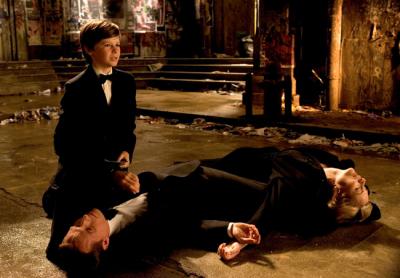
“Batman Begins” rightfully focused on the way Batman’s origin is defined by painful, horrific loss.
Though it presented a very complex character study of Batman, and one that adhered thematically to his comics’ counterpart, Batman Begins was still set very much in its own, very believable universe. Christopher Nolan, his brother Jonathan, and co-writer David Goyer drew from Batman’s mythology but didn’t feel bound to follow it, instead creating one of its own that very much spoke to its historical moment. It’s script, besides being incredibly sophisticated and full of extremely well-drawn characters, should be mandatory reading for prospective screenwriters as a perfect example of how to use “set up and pay-off,” as well as for establishing underlying themes. The cast was also world class, save perhaps for the miscasting of Katie Holmes as Batman’s love interest.
Also, while a great deal of focus has always been placed on The Dark Knight for its prominent post-September 11 symbolism, the fact is most of that symbolism began in Batman Begins; the film is essentially about terror and terrorism as themes, and its climax intentionally echoes the World Trade Center attacks, among many other elements. Between this and its overall quality, Batman Begins reasserted Batman to his rightful place as not only one of the world’s greatest superheroes, but also its most culturally significant one.
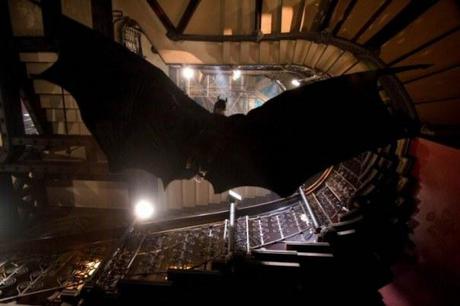
Batfact: Batman actually began in May 1939, with his first appearance in Detective Comics #27. The issue is commonly ranked as one of the most valuable comic book titles in history; at an auction in 2010, an edition classified in fine condition sold at auction for just over $1 million.

Where it all began: “Detective Comics” #27, the first appearance of “the Bat-Man.”
The Dark Knight (2008)
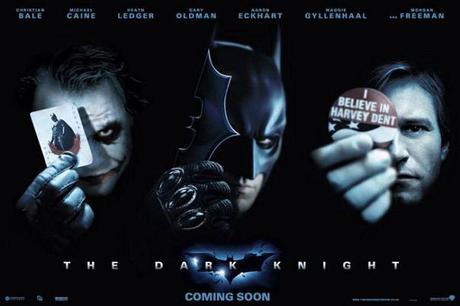
Not a film that needs any further endorsement from me, but needless to say, The Dark Knight is arguably the greatest superhero movie of all time and perhaps the most significant American film of the first decade of the 21st century. Essentially an epic urban crime saga wearing comic book trappings, this was, at its core, a trenchant political allegory for the War on Terrorism and the finite maturation of the superhero film genre. Mind you, I don’t actually agree with its politics (which lean very much towards the Right), but nonetheless it represents one of the most prominent works of post-September 11 culture, and it should be required viewing for that aspect alone.
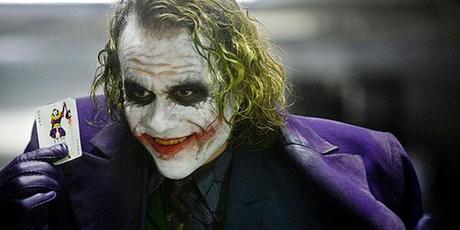
In what proved to be his final complete screen performance, Heath Ledger gave us in the Joker one of the greatest villains in Hollywood history.
Narratively, The Dark Knight retells the Batman-Joker conflict for the umpteenth time, bud did it in such a way that it made it feel like it was for the first. Heath Ledger gave what was the performance of his sadly shortened lifetime as a Joker who was less an insane madman than a articulate, charismatic, terrorist mastermind with a very specific ideological agenda; his loss only a few months before the film’s release imbued this already dark and tragic story with a further sense of loss (as well as increased expectations and hype for the movie itself), but even so, Ledger’s Joker deserves to be in the Pantheon of the greatest fictional movie villains of all time, right up there with Hannibal Lechter, Harry Lime, and Darth Vader. Often lost among the acclaim for Ledger was the performance of Aaron Eckhart, who was himself pretty much perfect as the idealistic but doomed Harvey Dent.
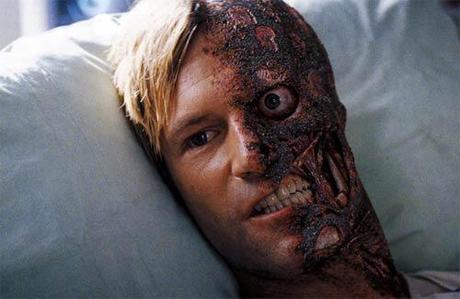
Often lost in the praise for Ledger’s Joker are platitudes for Aaron Eckhart’s Harvey Dent/Two-Face whose tragic fall is simultaneous heart-breaking and unsettling.
Perhaps the best thing I can say about The Dark Knight is that you in no way need to be a Batman or even a superhero fan to fully enjoy or appreciate it. It truly stands as a grand achievement of American filmmaking, and whatever Batman movie that was made before or will be made after will likely forever be in its very long shadow.
Batfacts: While the conflict between arch-enemies and antitheses Batman and Joker is among the most storied in popular culture, it was almost over just as it began. After making a memorable debut in Batman #1 (1940), the character was to be killed off in his second appearance; it was only due to a last minute call by editor Whitney Ellsworth that the character was spared and a new comic panel was drawn to establish that the character had survived a narrow brush with death.
The Dark Knight Rises (2012)
Whoa…let’s not get ahead of ourselves there, kids. I’ll tell you what…tune in next time, same anti-time, same anti-channel…

